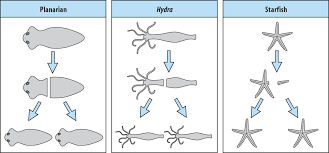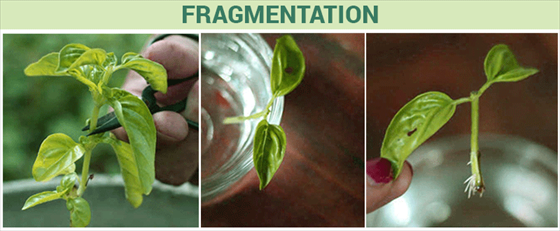Fragmentation is a type of asexual reproduction, which is similar to the regeneration in some aspects but at the same time, it is different as well. In this type of asexual reproduction, the parent organism is divided into various pieces, and then each piece will be developed into a complete and new individual. Spirogyra is reproduced by the fragmentation. It is a green-algae which freely floats on the freshwater ponds. If it is seen under the microscope, it is a rectangular cell whose nucleus is placed in the vacuole which is located in the center of the cell. These rectangular cells are joined by the filaments which are the long cells and when this filament is divided into pieces, each of these pieces will grow into the new individual filament.

In the vegetative reproduction of the plants, fragmentation is a very common kind of asexual reproduction. It occurs when a rooted shoot is detached from the main group. Fragmentation is a common phenomenon for both vascular and non-vascular plants and people use fragmentation to artificially propagate the plants, by layering, cuttings, grafting, and division. Fragmentation is a common method of asexual reproduction in some species of the ophiuroids, holothurians, and in the asteroids. Fragmentation requires a body that can be torn and can seal or heal the resultant wounds. Fragmentation occurs in the asteroids by pulling of the arms in the opposite direction, and the animal is torn into two pieces.

Flatworms also reproduce by fragmentation. They simply divide into the two pieces and each half will grow and will become the new individual. Fragmentation is also observed in the starfish and the new starfish is developed when the parent starfish is cut into two pieces. By the process of fragmentation, different colonies of the sponges and the corals have been produced. Architomy and parotomy are widely used terms for the splitting of the organisms due to the certain developmental changes.
At a specific point, the organism will divide into parts and both of the fragments will develop their tissues and the fragments. Before an organism can undergo the splitting, the formation of the furrow takes place at the splitting zone. The fragmented part that does not has the head will develop a new head. In the cases of paratomy, the splitting happens in the perpendicular direction of the anteroposterior axis. In this kind of fragmentation both of these fragments are developed in the head to tail fashion and their body axis is properly aligned.